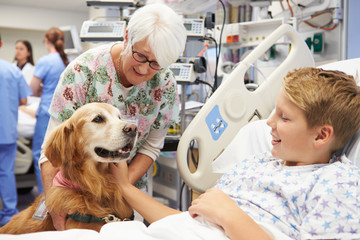Therapy animals provide immense benefits to patients. Pet therapy has been proven to reduce depression, anxiety, pain, and fatigue in patients with a variety of health conditions, as well as reinforce rehabilitation goals. According to a study by Tufts Institute for Human-Animal Interaction at Tufts University, 4 percent of hospitals and 22 percent of eldercare facilities had no policy whatsoever for animal assisted intervention (AAI); 16 percent of hospitals and 40 percent of eldercare facilities required only a minimal written health record for the therapy animal; and 18 percent of hospitals and 2 percent of eldercare facilities did not permit therapy dogs, allowing service animals only. (TuftsNow)
AAI occurs in a couple of approaches, animal-assisted activities (AAA) and animal-assisted therapy (AAT). The majority of animal therapy visits are for animal-assisted activities (AAA) and are meant to be motivational, educational and/or recreational. Volunteers, that have met specific criteria set by the healthcare organization, will bring their own animals to visit patients. There are no goals set or required documentation/records kept for these visits. These visits are usually spontaneous or last minute.
The primary difference between animal-assisted activities (AAA) and animal-assisted therapy (AAT) is that the AAT has specific criteria to be followed. That criterion includes the following:
- The visit/plan of treatment is overseen by a health and human service provider as part of his/her profession
- The professional must incorporate the animal as part of his/her own specialty
- The visit is goal-directed with a specific end in mind
- Each visit of AAT is documented in the client’s record with the activity and progress noted. (TJC FAQ)
In addition to the AAA and AAT pets can also be used as therapy animals, as therapeutic emotional support animals and service (assistance) animals. These animals are partners with their human. They may provide comfort, healing, freedom, and independence to those with disabilities, as well as therapeutic support for those with mental illness.
When deciding if pet therapy is right for your organization, it is important to consider issues related to infection control, handler’s background, and handler’s requirements. Background checks on the handlers with evidence of the health screenings both for the animal and the handler are important. Orientation to the organization will need to be provided including communication with the organization’s caregivers and information regarding interaction with patients.
The handlers need to assure the organization that their pets are friendly, confident, and not aggressive. Handlers need to understand that their pets need to be controllable, predictable, and reliable and will stay engaged when working with patients. They need to understand that they are part of the team that interacts with patients and their families.
Pet therapy can be very rewarding for patients. It is important to get your infection control department involved from the beginning and have them meet with leadership, staff, and handlers so that everyone on the team understands what the expectations are so to ensure a safe visit.
Regardless of what type of therapy animal you have in your organization the following should be considered prior to starting a pet therapy program.
- Find out what regulations your local Board of Health has regarding animals in healthcare facilities, as CMS and TJC currently have no regulations for pet therapy.
- Collaborate with your Infection Control Preventionist, Patient Care Services, Rehabilitation Services, Housekeeping and Risk Management to ensure a robust assessment that addresses animals in the care setting from every angle. As every animal species carries the risk of carrying certain bacteria or spreading certain infections.
- Perform a risk assessment.
- What are the responsibilities of the organization?
- Obtain the handler’s background check and pet health records.
- Ensure all vaccinations are up to date for the animal and that the animal is in good health.
- Maintain records on each animal permitted to enter the organization.
- Provide orientation to the facility for the handlers.
- Review all appropriate infection control policies with the handlers. Ensure they also understand their responsibility regarding privacy and confidentiality of patient information.
- Determine who is responsible for cleaning up after the animal.
- Determine who is responsible for providing/cleaning water/food bowl for the animal.
- Clean all surfaces that the animals may have licked or put into their mouth.
- Obtain permission for pet therapy from patient.
- Ensure that the patient is not allergic to the pet therapy animal.
- Educate patients regarding handwashing before and after touching the animal.
- What are the responsibilities of the pet owner/handler?
- Provide evidence that all vaccinations are up-to-date and that the animal is in good health.
- Never bring a sick animal into the organization.
- Ensure that the animal is clean including their collar, leash, and harness. Leashes should be cleaned/disinfected before arriving to the organization as well as after the animal leaves for the day.
- Before and after every contact, the handler and anyone petting or having contact with the animal need to wash their hands.
- Do not allow animals to lick or “kiss” those that they come in contact with.
- Keep the animal at least 6 feet away from those not participating in the visit.
- Handler should follow all infection control policies of the organization, i.e., handwashing, masking, etc.
- Ensure that the handler always maintains control of the animal.
In summary, pet therapy can be very rewarding and beneficial to patients in your organization from children to adults. Pet therapy can also be very beneficial for your staff members. Before embarking on the pet therapy journey decide what type of therapy you want to offer and involve your infection control department to assure that all requirements are met for having animals in your facility. For more information regarding pet therapy go to the Centers for Disease Control and Prevention website: Guidance for Handlers of Service and Therapy Animals | Healthy Pets, Healthy People | CDC
REFERENCES
- Considering Pet Therapy? Here’s How to Write Your Hospital’s Animal Policy, Leslie J. LaBelle, RN, MSN, MBA, CPHQ, Certified Green Belt, Associate Director, Enterprise Continuing Education, Licensed Dog Trainer and Evaluator. Published in TJC FAQ’s 7/20/2017.
- Could Therapy Animal Visitation Pose Health Risks at Patient Facilities? Nationwide survey of hospitals, eldercare facilities and therapy animal organizations reveal gaps in health and safety policies, TuftsNow, 9/21/2021.
- Centers for Disease Control and Prevention website, https://www.cdc.gov/healthypets/covid-19/service-therapy-animals.html


